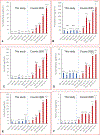Impact of smoking intensity and device cleaning on IQOS emissions: comparison with an array of cigarettes
- PMID: 36609493
- PMCID: PMC10323035
- DOI: 10.1136/tc-2022-057802
Impact of smoking intensity and device cleaning on IQOS emissions: comparison with an array of cigarettes
Abstract
Significance: IQOS is a heated tobacco product that has been widely advertised by Philip Morris International (PMI) as a reduced-exposure product compared with cigarettes. Reduced exposure results from reduced emission of toxicants which could be influenced by product constituents and user behaviour. This study aims to assess the influence of user behaviour, including device cleaning and puffing parameters, on toxicant emissions from IQOS.
Methods: IQOS aerosols were generated by a smoking machine using the combination of two cleaning protocols (after 1 stick vs 20 sticks) and five puffing regimes (including standard cigarette puffing regimes and IQOS-tailored regimes). The generated aerosols were analysed by targeted methods for phenol and carbonyl quantification, and by chemical screening for the identification of unknown compounds.
Results: Puffing parameters significantly affected phenol and carbonyl emissions while device cleaning had no effect. Harsher puffing conditions like more, longer, and larger puffs yielded higher levels for most toxicant emissions. Comparing the obtained data with data reported by PMI on 50 cigarette brands smoked under different puffing regimes showed various trends for phenol and carbonyl emissions, with IQOS emissions sometimes higher than cigarettes. Also, the chemical screening resulted in the tentative identification of ~100 compounds in the IQOS aerosols (most of limited toxicity data).
Conclusion: This study showed that puffing parameters, but not device cleaning, have significant effects on carbonyl, phenol and other emissions. Data analysis highlighted the importance of comparing IQOS emissions with an array of commercial cigarettes tested under different puffing regimes before accepting reduced exposure claims.
Keywords: Addiction; Carcinogens; Harm Reduction; Non-cigarette tobacco products; Smoking topography.
© Author(s) (or their employer(s)) 2024. No commercial re-use. See rights and permissions. Published by BMJ.
Conflict of interest statement
Competing interests: TE and AS are paid consultants in litigation against the tobacco and e-cigarette industry and are named on one patent for a device that measures the puffing behaviour of e-cigarette users and a patent application for a smoking cessation intervention. TE is also named on a patent application for a smartphone app that determines e-cigarette device and liquid characteristics. All other authors declare no conflict of interest.
Figures



Similar articles
-
Impact of More Intense Smoking Parameters and Flavor Variety on Toxicant Levels in Emissions of a Heated Tobacco Product.Nicotine Tob Res. 2024 Apr 22;26(5):571-579. doi: 10.1093/ntr/ntad238. Nicotine Tob Res. 2024. PMID: 38035623 Free PMC article.
-
Free-Base and Total Nicotine, Reactive Oxygen Species, and Carbonyl Emissions From IQOS, a Heated Tobacco Product.Nicotine Tob Res. 2019 Aug 19;21(9):1285-1288. doi: 10.1093/ntr/nty235. Nicotine Tob Res. 2019. PMID: 30476301 Free PMC article.
-
Carbonyl emissions from a novel heated tobacco product (IQOS): comparison with an e-cigarette and a tobacco cigarette.Addiction. 2018 Nov;113(11):2099-2106. doi: 10.1111/add.14365. Epub 2018 Jul 10. Addiction. 2018. PMID: 29920842
-
IQOS - a heat-not-burn (HnB) tobacco product - chemical composition and possible impact on oxidative stress and inflammatory response. A systematic review.Toxicol Mech Methods. 2020 Feb;30(2):81-87. doi: 10.1080/15376516.2019.1669245. Epub 2019 Oct 2. Toxicol Mech Methods. 2020. PMID: 31532297
-
Should IQOS Emissions Be Considered as Smoke and Harmful to Health? A Review of the Chemical Evidence.ACS Omega. 2022 Jun 22;7(26):22111-22124. doi: 10.1021/acsomega.2c01527. eCollection 2022 Jul 5. ACS Omega. 2022. PMID: 35811880 Free PMC article. Review.
Cited by
-
Young Adults' Attention to Reduced Exposure Claims in IQOS Advertising and Associations With Product Perceptions and Use Intentions.Nicotine Tob Res. 2025 Jan 22;27(2):351-359. doi: 10.1093/ntr/ntae195. Nicotine Tob Res. 2025. PMID: 39109909 Free PMC article.
-
The Product Science of Electrically Heated Tobacco Products: An Updated Narrative Review of the Scientific Literature.Cureus. 2024 May 28;16(5):e61223. doi: 10.7759/cureus.61223. eCollection 2024 May. Cureus. 2024. PMID: 38939262 Free PMC article. Review.
-
Heat-not-burn technology affects plasma testosterone levels and markers of inflammation, oxidative stress in the testes of rats.Front Toxicol. 2025 Jan 20;6:1515850. doi: 10.3389/ftox.2024.1515850. eCollection 2024. Front Toxicol. 2025. PMID: 39902465 Free PMC article.
-
Comparison of emissions across tobacco products: A slippery slope in tobacco control.Tob Induc Dis. 2024 Mar 30;22. doi: 10.18332/tid/183797. eCollection 2024. Tob Induc Dis. 2024. PMID: 38560551 Free PMC article. Review.
-
Impact of More Intense Smoking Parameters and Flavor Variety on Toxicant Levels in Emissions of a Heated Tobacco Product.Nicotine Tob Res. 2024 Apr 22;26(5):571-579. doi: 10.1093/ntr/ntad238. Nicotine Tob Res. 2024. PMID: 38035623 Free PMC article.
References
-
- Brawley OW, Glynn TJ, Khuri FR, et al. The first surgeon general’s report on smoking and health: The 50th anniversary. CA: A Cancer Journal for Clinicians. 2014;64(1):5–8. - PubMed
-
- Schroeder SA, Koh HK. Tobacco Control 50 Years After the 1964 Surgeon General’s Report. JAMA. 2014;311(2):141–3. - PubMed
-
- Smith CJ, Perfetti TA, Garg R, et al. IARC carcinogens reported in cigarette mainstream smoke and their calculated log P values. Food Chem Toxicol. 2003;41(6):807–17. - PubMed
-
- Murray JB. Nicotine as a Psychoactive Drug. The Journal of Psychology. 1991;125(1):5–25. - PubMed
Publication types
MeSH terms
Substances
Grants and funding
LinkOut - more resources
Full Text Sources
